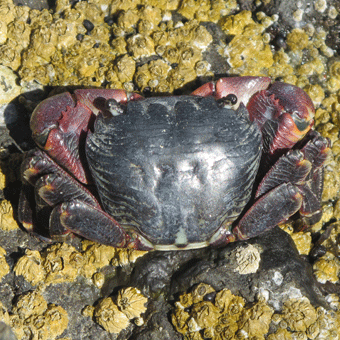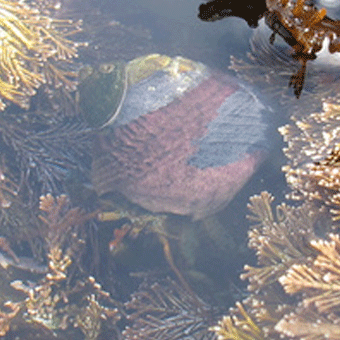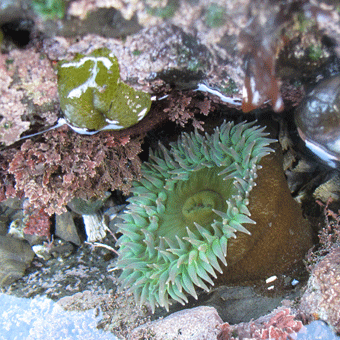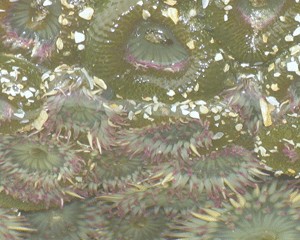Inhabitants of Oregon's Tidepools: Shore Crabs
Although shaped well to hide in cracks, shore crabs actively leave shelter to seek food.

Shore crabs can hunt and scavenge along the shore above the waterline because they can hold water in their bodies next to the gills, drawing on the oxygen from the stored water for some time. What if it rains? With their exoskeletons and their “above water breathing system,” shore crabs are also quite tolerant of exposure to rain and runoff.
The crabs and other animals under rocks are there because they require the protection: it’s important to replace anything you move to the original position to restore their protection.
What kind of shore crab did you find?
Inhabitants of Oregon Tidepools: Hermit Crabs

What would you do with a soft tail?
A hermit crab slips its soft abdomen into an empty shell. The crab is protected while nestled deep inside, sometimes nestled too deep to see. The delicate abdomen is gently curved to fit snuggly in the shell; trying to pull the crab out could rip it in half.
As the hermit crab grows, it needs larger shells. A large hermit crab in a too-small shell won’t be able to withdraw all the way into the shell, leaving it exposed to predators and thieving relatives. A small hermit crab in a very large shell may be able to withdraw so far that you wouldn’t be able to see it—even a shell that looks empty may not be.
Leaving shells on the beach leaves more hermit crab housing!
A shell is a shell?
Empty black turban snail shells are favored homes for hermit crabs; these durable shells can protect many generations of hermits long after the snail that made the shell has died.
Undisturbed, hermit crabs jostle and jerk along the tidepool bottom and through the seaweeds: slow moving snail shells are probably actually snails, fast moving snail shells are probably hermit crabs inside old snail shells.
Check out the short video clip of a hermit crab by clicking on the video camera icon on this page.
Inhabitants of Oregon's Tidepools: Anemones
Sea anemones thrive on a special partnership
 Green sea anemones have single-celled algae living in their tissues. The algae probably have a relatively safe place to live, but the sea anemone may get a good portion of its food from the algae, as well as some camouflage. Anemones living in dark crevasses are paler green.
Green sea anemones have single-celled algae living in their tissues. The algae probably have a relatively safe place to live, but the sea anemone may get a good portion of its food from the algae, as well as some camouflage. Anemones living in dark crevasses are paler green.
Similar to their jellyfish relatives, sea anemones use their tentacles to sting and retrieve prey. Small fish, open snails, and other intertidal animals are caught by the tentacles, pulled into the mouth, and eaten. An anemone with tentacles tucked insstyle=ide while underwater is probably eating; an anemone with tentacles tucked inside when out of the water is probably protecting its tentacles and mouth from drying and other damage.
Poking anemones may cause them to squirt out valuable water they need to stay hydrated during low tide, please observe gently.
 Aggregating Anemone
Aggregating Anemone
The most commonly encountered sea anemone in Oregon’s tidepools, aggregating anemones may be overlooked because they’re small. Aggregating anemones also thrive high up in the intertidal and people often overlook them because the anemones are closed up when exposed during the low tide that draws people to the shore. Aggregating anemones are often packed closely together, making it more difficult to make out individual animals; the shell bits on the outside complete the camouflage.
Why are aggregating anemones sometimes packed tightly together? Anemones reproduce by shedding eggs and sperm into the water, or by budding, or by splitting in two—cloning: aggregating anemones are especially good at cloning. A cloning aggregating anemone starts by stretching into a long oval then a long figure 8, eventually dividing into two genetically identical individuals.
Look for the pink-tipped tentacles in an open aggregating anemone while you’re looking for cloning individuals and boundaries between clone colonies. If you're lucky, you may even see the acrorhagi, or specialized tentacles used by this anemone to warn off members of other clones.

